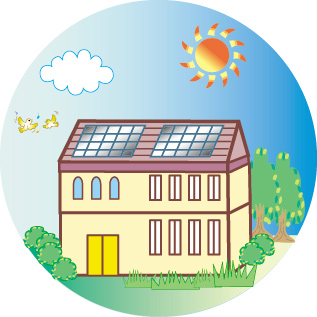Converting Sunlight into Electricity
 Sun light striking a solar panel causes the electrons inside the panel to flow, creating electricity. Solar power generating systems take advantage of this property to convert sunlight directly into electrical energy.
Sun light striking a solar panel causes the electrons inside the panel to flow, creating electricity. Solar power generating systems take advantage of this property to convert sunlight directly into electrical energy.
Solar panels produce direct current (DC), which goes through a power inverter to become alternating current (AC) — electricity that we can use in the home or office, like that supplied by your utility power company.
There are two types of solar power generating systems: grid-connected systems, which are connected to the Electricity company infrastructure; and stand-alone systems, which feed electricity to a facility for immediate use, or to a battery for storage.
Grid-connected systems are used for homes, public facilities such as schools and hospitals, and commercial facilities such as offices and shopping centres.
Electricity generated during the daytime can be used right away, and the surplus electricity can be sold to the Electric utility power company. If the system doesn’t generate enough electricity the electricity is purchased from the Electric power company. Power production levels and surplus selling can be checked in real time on a monitor, an effective way to gauge daily energy consumption.
Stand-alone systems are used in a variety of applications, including emergency power supply and remote power where the traditional arrangement is unavailable.
 Sun light striking a solar panel causes the electrons inside the panel to flow, creating electricity. Solar power generating systems take advantage of this property to convert sunlight directly into electrical energy.
Sun light striking a solar panel causes the electrons inside the panel to flow, creating electricity. Solar power generating systems take advantage of this property to convert sunlight directly into electrical energy.